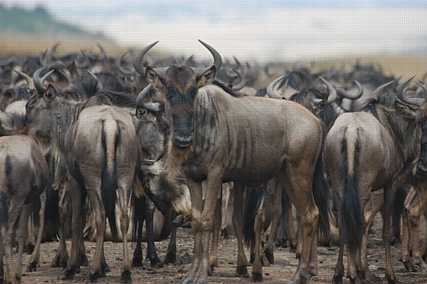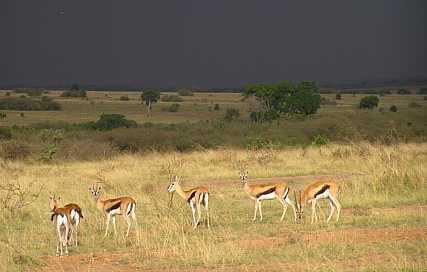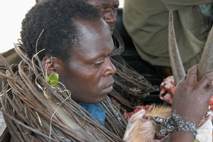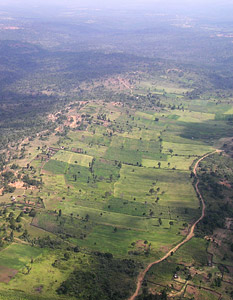Kenya’s Mara Conservancy is a model of community-based conservation. Amazing local and international observers with its success, this private, non-governmental agency has been managing infrastructure and anti-poaching efforts within the Triangle of Kenya’s Masai Mara Game Reserve for eight years. In the northern tip of the Serengeti-Mara ecosystem, the Maasai Mara Game Reserve was gazetted in the late 1940s. The Mara River, descending from the currently threatened Mau Forest, separates the Mara from the reserve’s eastern sector.

An impression of the wildebeest migration 2005
When the Serengeti enters its annual dry spell, the Mara’s western Triangle and the perennial Mara River become the destination for the world’s largest mammal migration of almost two million wildebeest and zebra. Annually, between July and November, these ungulates seek the waters of the crocodile-crowded Mara River and the nutrients in grasses freshened by rains from Lake Victoria. However, recently the Mara River has almost run dry due to climate variations and deforestation in its headlands, the Mau Forest.
A wealth of flora and fauna are found on the banks of Mara River and under the shadow of its dramatic Rift Valley Isuria Escarpment. Osa and Martin Johnson, whose images are copyrighted by the American Museum of Natural History, were among the first to photograph the Mara Triangle. Since then George Shaller, Joan and Alan Root, Nigel Pavitt, Jonathon Scott, Art Wolfe and many others have published photographic books and films documenting both the broad and intimate landscapes in the Mara Triangle.

Recurring afternoon thunderstorms keep the grasses green for many species of grazers in the Mara Conservancy including the millions of wildebeest and zebra migrating north from the dry Serengeti plains.
By 1999, however, conditions in the Mara Triangle had greatly deteriorated due to mismanagement. Poaching was rampant. Infrastructure of roads and tourists services had all but disappeared. It was obvious that income was not being properly distributed to the Maasai communities who own the land, nor was money being put back into maintenance of the reserve. Safaris were no longer heading into the Mara Triangle.
The Maasai living on the Trans Mara Isuria Escarpment above the Triangle asked Willie Roberts, a Kenyan conservationist, to devise a management plan that would restore the Triangle so it could once again bring in revenue for local communities. James Robertson who is another Kenyan wildlife conservationist, a U.S. friend and I accepted Willie’s invitation to view the desperate condition of this 510-square-kilometer national reserve; to listen to his management vision for the Mara Triangle; and to meet with Kijabe and Tunai, the Maasai chiefs who were asking for help in changing these conditions.

A captured Tanzanian poacher wears his wire snares around his neck and holds in his lap the head of a snared antelope.
It was an easy decision to endorse the start-up of the Mara Conservancy. Whatever risk there was that Willie’s plan might not work was negated by the obvious necessity to act immediately to save this ecosystem and its annual migration. Willie’s new paradigm of community-based conservancy created with the assistance of other experienced conservationists, lawyers and tour operators would allow the migration to flourish without the threat of poachers. A management plan was created to protect endangered fauna, nourish flora including the few remaining balanites trees, and benefit contiguous Maasai communities through transparent distribution of their deserved share of tourism revenue. This plan has been very effectively directed and enforced by the Mara Conservancy’s executive director Brian Heath.
The Mara Conservancy began managing the Mara Triangle June 11, 2001, based on the premise that its most tangible and significant income would be derived from tourism revenue. As the first public/private sector conservation partnership in Kenya, the Mara Conservancy fulfilled its first five-year contract and entered a new ten-year contract in October 2005. Supported by a generous U.S. donor, creation of a new ten-year management plan was begun in 2007 and will ensure greater, long-term security for this world-renowned game reserve.
Among the Mara Conservancy’s primary objectives is effective management of the Mara Triangle’s riverine forest, the Mara River, the annual wildebeest and zebra migratory phenomenon, and other flora and fauna. With its successful scheduled sharing of revenue with the Trans Mara Maasai and employment of locals from its inception, the Mara Conservancy has:
- served as a model for private management of protected areas when African governments are too pressed by dire humanitarian issues caused by droughts, wars, disease and illiteracy to be able to address conservation needs;
- demonstrated that private management of land under conservation can create significant economic returns for local communities through job creation and alleviation of poverty and education of the public;
- protected species from poaching and addressed ecological issues of deforestation and droughts.
The Mara Conservancy goals are to eventually reintroduce the roan antelope and wild dog, to ensure a healthy population of threatened species such as rhino and lion, and to study means of facilitating regeneration of the dwindling numbers of balanites trees and forest and woodland cover in general.
While the 2008 post-election strife in Kenya has caused budgetary cutbacks, foreign donor support is helping to mitigate the negative effects from the current temporary loss of tourism dollars. This model of community-based conservation has proved that protection of important watershed eco-systems, flora and fauna can jointly benefit local communities, generations of tourists to come and sustainability of indigenous species. The next great challenge to preserving this Mara Triangle reach of the Mara River is to protect the Mau Forest which is the Mara River headlands and one of the key water sources in Kenya.

Kenya: Mau Forest, aerial view of settlement and farming plots, 2003
During the post-election 2008 upheavals, many whose lives were disrupted fled to the Mau Forest for access to sources of charcoal or farmland. Aerial surveys in January show that the western side of these headlands has become heavily settled. The recent increase in encroachment and devastation of the Mau canopy forest threatens the livelihoods of thousands of people in Kenya, Tanzania, Uganda, Sudan and Egypt – as well as the flora and fauna in ecosystems such as the Mara Conservancy.
Now that peace has been brokered in Kenya, a new coalition form of government is in place. According to the Kenya Forest Service director, Mbugua, Kenya Wildlife Service and Kenya Forest Service are ready to work together to enforce security in the Maasai Mau Forest. Downstream, the Mara Conservancy’s efforts in community-based conservation depend on the success of these two para-statal services in managing the Mau Forest and thus preserving the source of the Mara River.
For further information on the Mara Conservancy, see www.maraconservancy.com. Information on the Mau Forest comes from Kenya’s Daily Nation, “Poll chaos threat to survival of key water source” by Ken Opala, March 11, 2008. Accessed 3-10-08.